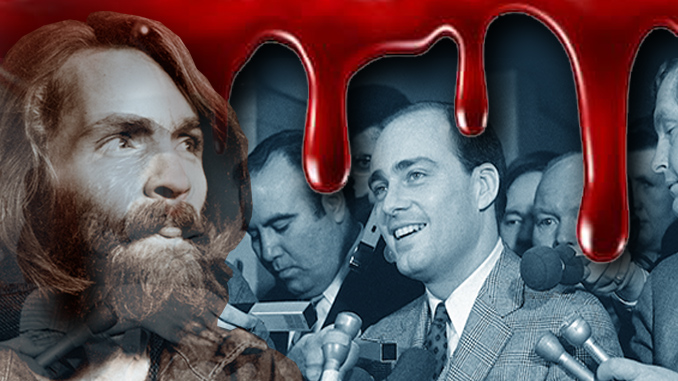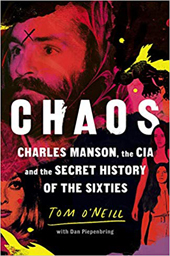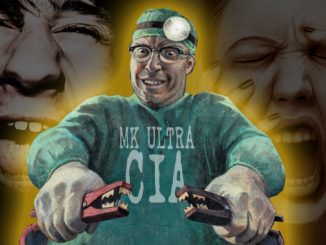
A new book from Tom O’Neill challenges the entirety of the Charles Manson mass-murder narrative put forth by LA attorney Vincent Bugliosi in Helter Skelter.
By S.T. Patrick
After the end of the Tate-LaBianca murder trial in 1971, history really was, as the adage dictates, written by the winners. Charles Manson, Susan Atkins, Leslie Van Houten, and Patricia Krenwinkel had been convicted and sentenced to death. Charles “Tex” Watson was convicted for the murders in a separate trial after fighting extradition from Texas where he was apprehended.
In 1974, after leaving his position as the Los Angeles County deputy district attorney, Vincent Bugliosi, who had successfully prosecuted the Tate-LaBianca case, wrote Helter Skelter with author Curt Gentry. It has, to date, become the bestselling true crime book in American history, tallying over 7 million copies sold. Until this decade, it had also become the bible of the Manson story.
Bugliosi laid the groundwork for the massive merchandising spree that would come from the Manson case. Movies (including two made from Helter Skelter), documentaries, books, t-shirts, buttons, and the grotesque rise of “murderabilia” collectors followed the mythological demonization of the story’s principals. In the 1970s and 1980s, Manson’s music albums became the hottest underground bootlegs. Manson was money, thanks to Bugliosi’s portrayal of a Beatles fascination, a determination to start a global race war, and zombified hippie beauties pledging loyalty to their huckster- philosopher.

But with the release of Tom O’Neill’s Chaos: Charles Manson, the CIA, and the Secret History of the Sixties, we are now looking at Manson, his “Family,” and Bugliosi in a refreshing, more factual way than we have ever before.
The prologue to Chaos should not be missed. In it, the author describes a contentious interview conducted at the Bugliosi home. The Manson prosecutor exaggeratedly oscillates through reading long sections of text in defense of his prosecutorial methods, threatening O’Neill in a variety of manners, and being his own hype man, reading laudatory words spoken about him over the last half-century. O’Neill was assuredly on Bugliosi’s home court, and the environment was hostile. What O’Neill later found was that Bugliosi had built a legacy of threatening journalists who challenged him. At one point, the famed prosecutor had told Mary Neiswander that he knew where her children attended school and “it would be very easy to plant narcotics in their lockers.” But, as author Jim DiEugenio points out, “What was the famous prosecutor so worried about? What secrets was he so desperately trying to protect?”
O’Neill answers those questions adeptly in the strongest section of Chaos, his repudiation of Bugliosi as a prosecutor, an historian, and the author of anything true regarding the crime genre.
One of the most egregious was his handling of Atkins and Linda Kasabian. Atkins had been talking while detained. Reportedly, she had talked to a least four others about the case. Bugliosi wanted her to talk and to say what he wanted said to the grand jury. He, therefore, and with the judge’s agreement, arranged to have Atkins’s attorney replaced by one who was more favorable to the prosecution, Richard Caballero, who had spent eight years in the DA’s office. Atkins’s new attorney got her to talk without any written or verbal agreement. Not only did this help buoy what would become the “Helter Skelter Myth,” but it also brought Manson’s name into the case for the first time. Atkins later reneged on many of the plot points in the story, including the satanic ones such as drinking the blood of murdered actress Sharon Tate.
When Kasabian proved to be a better witness for the trial itself (she had not participated in the Gary Hinman murder, as Atkins had), Atkins was disregarded and cast away, something Caballero couldn’t challenge without a written agreement, and something he wouldn’t have challenged anyway, as his position alone was initiated so that Atkins would be agreeable to the prosecution’s goals.

Manson historian Nikolas Schreck, the author of The Manson File, has long argued that the Tate-LaBianca murders were a series of drug deals gone bad. O’Neill strongly agrees with this, as well, highlighting how Bugliosi detached Terry Melcher, son of actress Doris Day, and any links to the mob-influenced southern California drug culture from Manson, thus leaving the defendants with no case.
In the words of Krenwinkel attorney Paul Fitzgerald, Bugliosi wrote a script that he unethically maneuvered his witnesses to follow. Once O’Neill dismantles the structure of Bugliosi’s case and the deceitfulness of his methods, he and co-author Dan Piepenbring attempt to write a detective story of what Manson, his “Family,” and the case really were. Because it is all informed speculation at this point—as O’Neill readily admits—it doesn’t have the same effect in destroying historical mythology as exposing Bugliosi does. Yet, the sections on the CIA, mind control at Vacaville Prison Medical Facility, COINTELPRO, and Ronald Reagan’s California still ring fascinating. O’Neill’s book also has value for anyone interested in the differences in the members of the “Family,” as they are stark and surprising.
O’Neill has done something unheard of in modern historical analysis: He has gotten the mainstream media to look at an accepted case in a different way. That is the power of Chaos. And for this, it will remain one of the single most important tomes ever written on the Tate-LaBianca murders, on Manson, and on the individuals who gathered seeking a different life on Spahn Ranch.
S.T. Patrick holds degrees in both journalism and social studies education. He spent 10 years as an educator and now hosts the “Midnight Writer News Show.” His email is [email protected]. He is also an occasional contributor to TBR history magazine and the current managing editor of Deep Truth Journal (DTJ), a new conspiracy-focused publication available from the AFP Online Store.






Excellent article. We need more like it. Bugliosi’s butchering of the truth is perfect way to say it. Personally, I wish MR ONeil had been more definitive at the end of his book, but the attacks and threats made to authors who explore this subject is well known. Wonder why? It’s obvious. I hope history will finally catch up with Bugliosi and this case, so all the connections and links are laid bare. The mainstream media tried to ignore the book as much as possible. Hardly surprising. Hopefully others will pick up where ONeil left off. But I believe what would break open this case would be the files – government, LA police, etc. Let’s hope. We need more whistle blowers.
So easy to challeng someones work after they are dead. There is not doubt that with the contrast between the limited rights of criminal defendants in the past as opposed to the more liberal rights set by the Supreme Court today, Charles Manson would have never been convicted of these infamous murders had they been in 2019. Mr Bugliosii was an incredible DA and famously hated jurnalists, who are rarely held accountable for anthing what they write about an interview no matter how out of context it is.